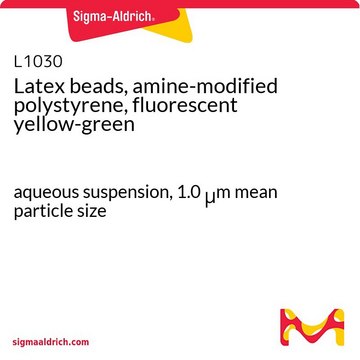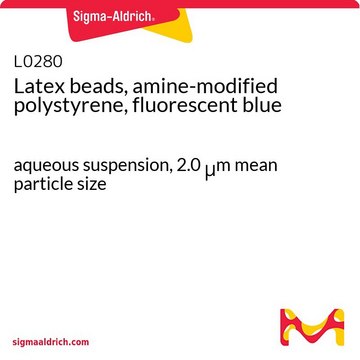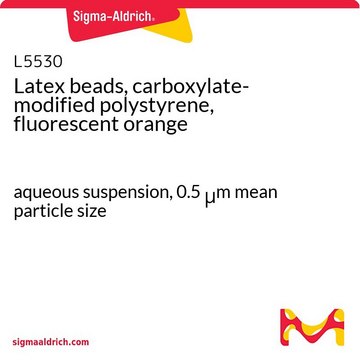L9904
Latex beads, amine-modified polystyrene, fluorescent orange
aqueous suspension, 0.1 μm mean particle size
Synonyme(s) :
Amine-Modified Latex Beads, Fluorescent Orange Beads
Se connecterpour consulter vos tarifs contractuels et ceux de votre entreprise/organisme
About This Item
Produits recommandés
Forme
aqueous suspension
Composition
Solids, 2.5%
Technique(s)
cell based assay: suitable
Taille moyenne des particules
0.1 μm
Fluorescence
λex ~475 nm; λem ~540 nm
Application(s)
cell analysis
Vous recherchez des produits similaires ? Visite Guide de comparaison des produits
Application
Amine-modified polystyrene latex beads have been used to develop an electrochemical nitrite nanosensor as well as to validate a pharyngeal aspiration technique for exposing the mouse lung to respirable particles.
Latex beads, amine-modified polystyrene, fluorescent orange has been used in the preparation of nano-particles in biophysical characterization. It has also been used in the preparation of nano-particles for cytotoxicity studies in yeast and cell lines.
Code de la classe de stockage
10 - Combustible liquids
Classe de danger pour l'eau (WGK)
WGK 3
Point d'éclair (°F)
Not applicable
Point d'éclair (°C)
Not applicable
Faites votre choix parmi les versions les plus récentes :
Déjà en possession de ce produit ?
Retrouvez la documentation relative aux produits que vous avez récemment achetés dans la Bibliothèque de documents.
Les clients ont également consulté
Toshiyuki Nomura et al.
Chemosphere, 149, 84-90 (2016-02-09)
The effects of surface physicochemical properties of functionalized polystyrene latex (PSL) nanoparticles (NPs) and model filamentous fungi Aspergillus oryzae and Aspergillus nidulans cultivated in different environment (aqueous and atmospheric environment) on the colloidal behavior and cytotoxicity were investigated in different
Exposure of the yeast Saccharomyces cerevisiae to functionalized polystyrene latex nanoparticles: influence of surface charge on toxicity
Nomura T, et al.
Environmental Science & Technology, 47(7), 3417-3423 (2013)
Esen Efeoglu et al.
The Analyst, 142(18), 3500-3513 (2017-08-24)
Nanotoxicology has become an established area of science due to growing concerns over the production and potential use of nanomaterials in a wide-range of areas from pharmaceutics to nanomedicine. Although different cytotoxicity assays have been developed and are widely used
Edwin H Shin et al.
Nanoscale, 5(13), 5879-5886 (2013-05-24)
The use of nanoparticles for cellular therapeutic or sensing applications requires nanoparticles to bind, or adhere, to the cell surface. While nanoparticle parameters such as size, shape, charge, and composition are important factors in cellular binding, the cell itself must
G V S Rao et al.
Journal of toxicology and environmental health. Part A, 66(15), 1441-1452 (2003-07-15)
Recent studies have demonstrated that the mouse lung can be exposed to soluble antigens by aspiration of these antigens from the pharynx. This simple technique avoids the trauma associated with intratracheal instillation. In this study, the pharyngeal aspiration technique was
Notre équipe de scientifiques dispose d'une expérience dans tous les secteurs de la recherche, notamment en sciences de la vie, science des matériaux, synthèse chimique, chromatographie, analyse et dans de nombreux autres domaines..
Contacter notre Service technique













